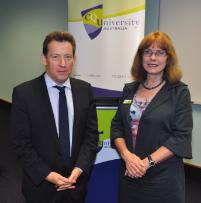Higher education reforms bearing fruit, says visitor
Published on 10 October, 2012
Reforms made to Australia's higher education system are bearing fruit in the areas of expenditure, participation and quality.
That's according to Phil Aungles, from the federal Tertiary Education department, who was delivering a keynote address to the Australasian Higher Education Evaluation Forum (AHEEF) 2012, being hosted by CQUniversity Rockhampton Campus this week.

Forum keynote Phil Aungles with CQUniversity Deputy VC Professor Hilary Winchester
"In 2009, the Australian Government launched a package of reforms ... to educate the graduates needed by an economy based on knowledge, skills and innovation," Mr Aungles said.
"These reforms were designed to achieve two overarching objectives: increased productivity, and greater social inclusion and social mobility. Central to the package of reforms was the move to a demand-driven system of funding for bachelor degree places."
Mr Aungles showed a graph indicating the government is well on track to achieve its target of 40 per cent of 25-34 year olds attaining a bachelor-level qualification or above by 2025.
"In 2011, 35 per cent of 25-34 year olds had attained this level of qualification, up from 32 per cent in 2008. Women have already met the target in 2011 (40 per cent).
"With the rapid growth in student places as a result of the introduction of the demand-driven funding system, departmental projections suggest that the 40 per cent attainment target will be achieved by 2023."
Mr Aungles showed another graph indicating that the proportion of students from a low socio-economic background is improving. In 2011, 16.8 per cent of undergraduate students were from a low SES background, up from 16.1 per cent in 2007.
While talking up quality assurance measures, the visitor sounded a note of caution about attrition rates.
"Over the last decade there does appear to have been a steady drift downward in the attrition rate from 18.1 per cent in 2001 ... to 15.6 per cent in 2009. However, the 2010 attrition rate has ticked back up to 16.5 per cent.
"Attrition rates increased for students of all ability levels in 2010. Importantly, this suggests that it is not just the entry of low ability students that is associated with the increase in attrition."
Mr Aungles noted that the relative unemployment rate of graduates compared to the overall unemployment rate has been unchanged across the entire period from 1979 to 2011.
"The relative unemployment rate measures the competing balance of demand and supply pressures for degree qualified vis a vis labour in general. This suggests that, notwithstanding the very large scale in expansion in education over the period, including in higher education, that graduates are no more or no less in excess demand or excess supply and that ‘balance' of some sort has been maintained in the graduate labour market."
Mr Aungles said that a fresh move to measure employer satisfaction with graduates would ensure higher education remained responsive to employer and labour market needs.
He said the MyUniversity website devised to enable prospective students and their parents had received over 1.3 million page views since its launch.

